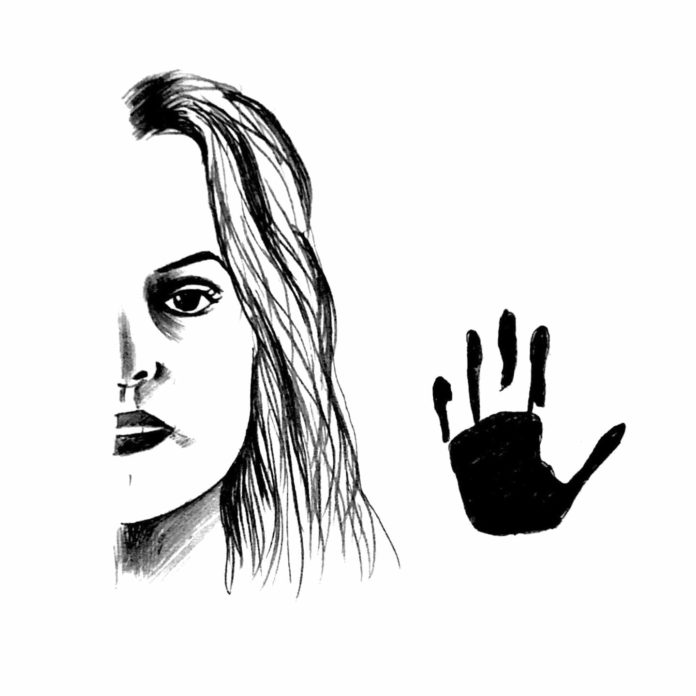What you can’t see can hurt you. The movie catchphrase from Blumhouse’s recent hit “The Invisible Man,” directed by Leigh Whannell, seems coincidentally relevant during the current coronavirus pandemic — particularly when President Trump called COVID-19 “the invisible enemy.” It is a timely admonition for anyone: the threat is lurking.
A successful adaptation of H. G. Wells’ literary classic “The Invisible Man” with a modern feminist spin, the 2020 film of the same name focuses on the ugly fallout of an abusive relationship. Opening with the unnerving escape of Cecilia (Elizabeth Moss) from a deluxe mansion above the ocean in the middle of the night, the film tracks the tortuous path of the haunted and hunted damsel. The mansion belongs to her boyfriend Adrian (Oliver Jackson-Cohen), an accomplished but morbidly possessive optics scientist. To leave the house, Cecilia passes through a succession of security doors, disables security cameras, climbs through the fencing walls and runs through the woods to the highway, where she anxiously awaits her sister Emily (Harriet Dyer). Compared to the 1933 adaptation directed by James Whale, this version gives little backstory to the mad scientist. It is only through the perspective of Cecilia that the film immerses us in an experience of panoramic paranoia, unspoken fear and heartbreaking helplessness and offers insights into the mysterious and dangerous person Adrian is.
Alfred Hitchcock famously distinguished a bomb going off from the audience anticipating it to go off, and Whannell deftly and mischievously plays with this audience expectation — sometimes too playfully. After Adrian’s suspicious suicide, Cecilia soon comes to believe he is not dead but is preying on her in inexplicable ways. The audience knows better. After repeated attempts to conquer her fear of going outside, Cecilia eventually gathers her courage to step outside the house to feel the peace of the night. Just when she takes a deep breath in relaxation, another mist of breath appears beside her. She goes inside and leaves the door half closed, unknowingly allowing the threat to follow her.
Other signs further reveal that Cecilia is not yet free from danger, including a missing knife from the kitchen, a handprint on the shower door, an eerie flash in the dark and a phone ringing from the attic. Whannell leaves you in suspense as if putting a chokehold on your neck, but always gives you just enough space to breathe. Particularly suffocating is the film’s extensive use of negative space and aimless camera movement that resembles a roaming ghost. The visual kenophobia is most evident when Cecilia is left alone — when nobody trusts her anymore and she has to take matters into her own hands.
While Cecilia’s constant uptightness could be understandably interpreted by those around her as a manifestation of post-traumatic stress disorder, she is never a delusional lunatic. Compared to the gory thrills and blatant violence later in the film, Cecilia’s isolation from and distrust of others is the lasting horror of the story.
This specific brand of horror may be especially potent right now because it crosses the boundary into reality. Those who took early precautions and tried to convince the public about the dangers of COVID-19 were sniffed at and discriminated against — made to experience a fate of distrust similar to Cecilia’s. Despite the examples of China, Italy and South Korea, as well as early warnings from both health experts and politicians, the American government and media continued to downplay the situation until March 13. The effect of this denial was confusion and frustration. Asians and Asian-Americans with families in China who learned about the dire consequences of the situation the hard way were shamed, and health experts who advocated for early preventions were blamed for fear mongering. People seem to forget we are all together on the same sinking boat.
Elizabeth Moss’ brilliant portrayal of Cecilia’s assorted and sometimes conflicting emotions may be attributed to experience gained from her previous roles. In 2007, Moss co-starred in “Mad Men” as Peggy Olson, a talented and ambitious ingenue competing in the 1960s male-dominated business of marketing. In 2017, Hulu’s adaptation of Margaret Atwood’s “The Handmaid’s Tale” features Moss as June Osborne, an ordinary mother and wife who is captured as a child-bearing slave in a future dystopian society. Both of these women are strong and resilient, writhing and surviving through hurdles and struggles — sometimes successfully and often not — and the audience is able to see these qualities in Cecilia as well. Involuntary as her resistance is as she scrambles to rid herself and her loved ones of Adrian, she indubitably foresees the lurking danger when nobody else does and faces it head on. Her wit in a battle scene in the house is extraordinary, and her consistent demonstration of courage guised in despair has larger implications about what damage can occur when nobody takes heed of warnings. She is fighting back against the odds, through which we are able to see part of ourselves. If we are blinded by our smug self-deceit for too long, we might not be able to act before the invisible force hits us.
![]()




































